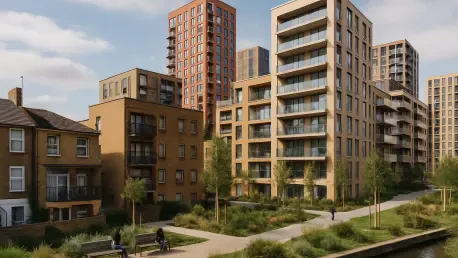In the heart of East London, the Isle of Dogs stands as a testament to rapid urban evolution, where the demand for housing continues to outpace supply, creating a pressing challenge for developers and policymakers alike. With Tower Hamlets Council approving the regeneration of Tiller Road Estate, a pivotal opportunity emerges to dissect how such projects influence housing markets, community structures, and long-term investment potential. This analysis aims to unpack the market implications of replacing outdated low-rise blocks with 411 modern homes, including 137 affordable units, while exploring broader trends in estate regeneration across London. The focus is not just on numbers but on how this initiative, led by Mount Anvil and social landlord Riverside, reflects shifting dynamics in urban development and housing affordability.
Diving into Market Trends and Data
Regeneration as a Catalyst for Housing Supply
The Tiller Road Estate regeneration project marks a significant intervention in East London’s housing market, where chronic shortages have driven prices to unsustainable levels for many residents. By transforming three aging blocks containing just 72 homes into a development with 411 residences, the project directly addresses supply constraints in a high-demand area like the Isle of Dogs. Market data indicates that housing completions in Tower Hamlets have struggled to keep up with population growth, with a deficit of thousands of units annually. This redevelopment, featuring high-rise towers of 21 and 25 stories alongside mid-rise blocks, showcases a trend toward densification as a solution, maximizing land use in a spatially constrained urban zone. However, the challenge lies in ensuring that such density does not compromise livability or alienate existing communities accustomed to lower-scale environments.
Affordable Housing Quotas and Market Balance
A critical aspect of this regeneration is its commitment to delivering 137 affordable homes alongside private sale and shared ownership options, reflecting a nuanced approach to market diversity. In London’s housing landscape, where affordability remains a persistent issue, projects like Tiller Road are under scrutiny for their ability to balance social objectives with financial viability. Current market analysis suggests that while affordable housing quotas are a positive step, they often represent a fraction of total demand, with waiting lists for social housing in Tower Hamlets stretching into the thousands. The partnership between Mount Anvil and Riverside highlights a growing reliance on public-private collaborations to bridge this gap, yet risks of gentrification loom large if market forces prioritize higher-income buyers over local needs. This tension underscores the need for robust policy frameworks to sustain equitable outcomes.
Community Infrastructure as a Value Driver
Beyond raw housing numbers, the Tiller Road project emphasizes community infrastructure—upgraded landscaping, safer pathways, and communal spaces—as a key component of urban renewal. From a market perspective, such enhancements can significantly boost property values and attract diverse demographics, positioning the area as a desirable residential hub near Canary Wharf’s financial district. Comparative analysis with nearby developments, such as those in Royal Eden Docks, reveals that projects integrating communal amenities tend to see higher resident satisfaction and longer-term investment stability. However, the success of these features hinges on effective maintenance and alignment with resident preferences, as poorly managed spaces can detract from market appeal and undermine developer credibility in future ventures.
Projections for Estate Regeneration Markets
Growth of Public-Private Partnerships
Looking ahead, the collaboration between Mount Anvil and Riverside, which spans four London sites and over 1,000 homes in development, signals a robust trajectory for public-private partnerships in the estate regeneration market. Industry forecasts predict that such joint ventures will dominate urban housing strategies through at least 2027, driven by local authorities’ limited budgets and developers’ access to capital. The Tiller Road project serves as a benchmark for how these partnerships can deliver scale while addressing social housing needs, though economic fluctuations could impact funding availability. Market watchers anticipate that sustained government incentives and regulatory support will be crucial to maintaining momentum in this sector.
Sustainability and Technological Integration
Another emerging trend shaping the regeneration market is the push for sustainability, with projects like Tiller Road incorporating energy-efficient designs such as improved insulation to reduce environmental impact. Market projections suggest that green building standards will become non-negotiable in urban developments over the next few years, driven by stricter regulations and consumer demand for lower utility costs. Additionally, advancements like modular construction are expected to gain traction, potentially cutting costs and timelines for similar initiatives. These innovations could redefine competitive edges for developers, positioning those who adopt early as market leaders while challenging others to keep pace with evolving expectations.
Market Risks and Adaptive Strategies
Despite optimistic projections, the estate regeneration market faces notable risks, including potential shifts in local policy or public sentiment that could delay or derail projects. Economic downturns might also constrain financing for large-scale developments, impacting timelines and affordability commitments. For Tiller Road, ensuring resident buy-in during the transition to high-rise living will be critical to market perception, as community backlash has historically affected property demand in comparable areas. Developers and stakeholders must adopt adaptive strategies, such as phased construction or flexible housing mixes, to mitigate these uncertainties and maintain investor confidence in regeneration as a viable market segment.
Reflecting on Strategic Implications
Looking back, the analysis of Tiller Road Estate’s regeneration provides a comprehensive view of how targeted urban renewal reshapes housing markets in East London, highlighting both opportunities and challenges. The project’s blend of increased density, affordable housing provisions, and community-focused design offers valuable lessons for balancing market demands with social good. Moving forward, stakeholders should prioritize transparent engagement with residents to ensure alignment between development goals and local needs. Developers might explore innovative financing models to safeguard affordability amid economic pressures, while policymakers could strengthen regulatory oversight to prevent inequitable outcomes. Ultimately, the insights gained underscore the importance of adaptability and inclusivity in crafting future urban housing strategies that truly transform communities for the better.









